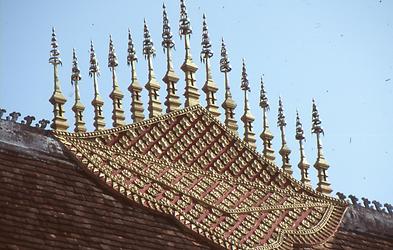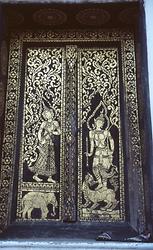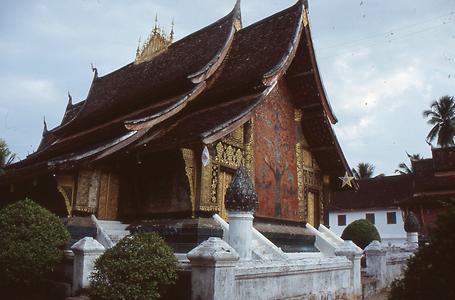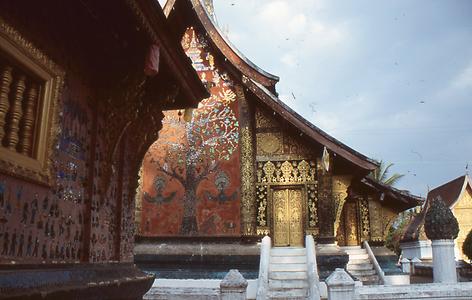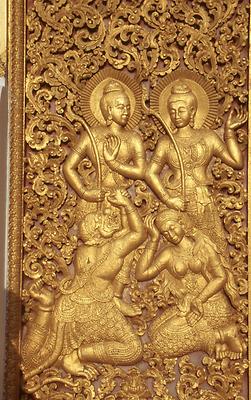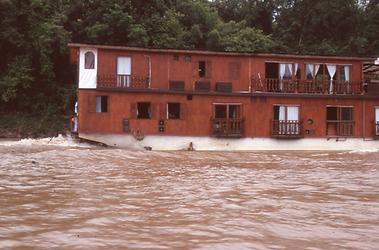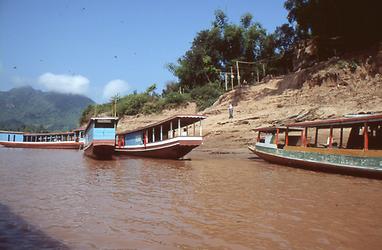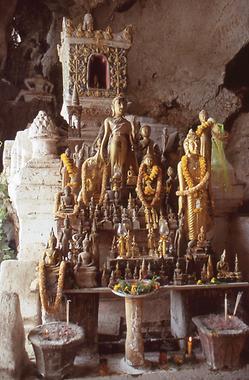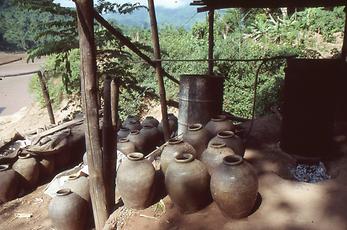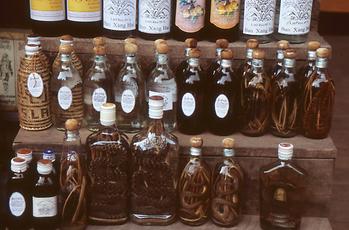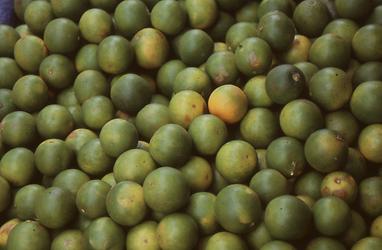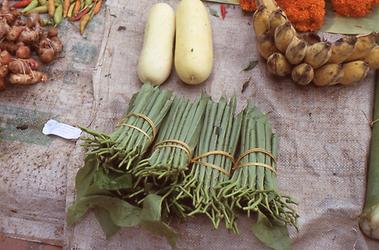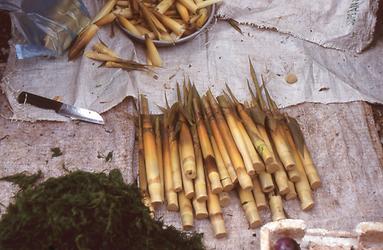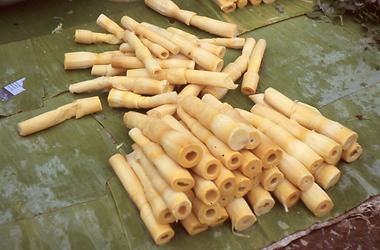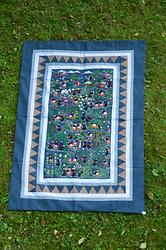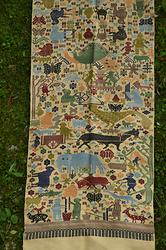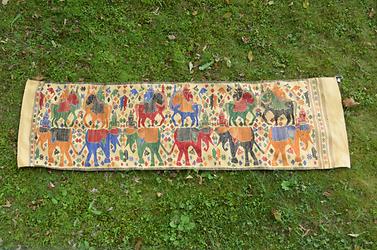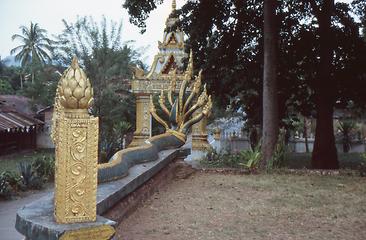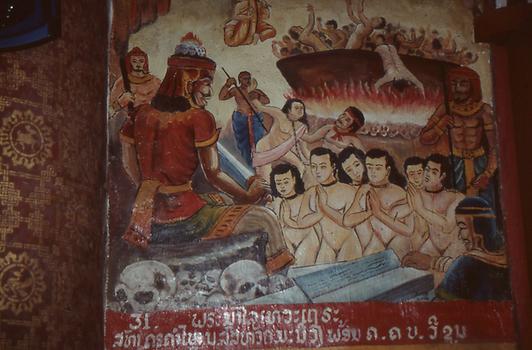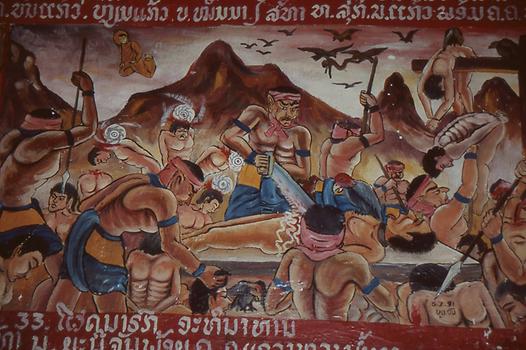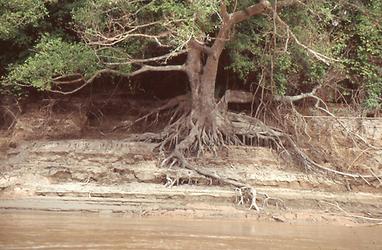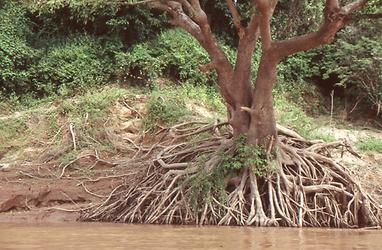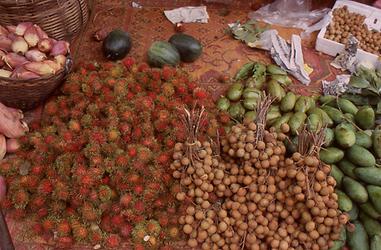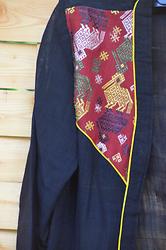by
Günther Jontes
The pictures were taken by the author in the years 2003 and 2009 in Laos. They are part of the author's archive "pictureflood Jontes". The sample of textiles and the clothing shown are part of the ethnographical collection of the author.
All South-East Asian countries have access to the sea. Laos is the only landlocked country. Through its territory, however, flows one of the largest rivers of the earth, the Mekong. Concerning the area of influence, length and quantity of water it is the 12th largest river worldwide. It crosses on its course six countries. It is about 4500 km long. The river basin that is important for all of South-East Asia has 800.000 km2.
The Mekong, in Lao Mac Nam Khong is a border river between Laos and Burma/Myamar for 200 km. It is one of richest waterways on earth. Some 1200 species of fish, including the endangered Mekong giant catfish, the largest freshwater fish ever, live in it.
When flowing over certain geological formations, the colour turns red. This happened also in numerous wars which Laos has suffered.
Then it was real blood.
Despite its landlocked situation Laos water plays a very strong role in the country, much based on the Mekong. The country is officially called Lao People’s Democratic Republic, (in Lao Sathanalat Paxthipatai Paxaxon Lao). With its 236.800 km2 it has three times the size of Austria, but has only 6,7 million inhabitants.
This country with its long history has suffered a lot in the 20th century. As a Kingdom with rich traditions it was a part of French Indochina. Through the assumption of power by communism, coming from Vietnam, Laos was drawn into the Vietnam War. In Laos there was the Ho Tschi Minh trail, which was vital for the supplies of the Vietcong. Therefore Laos was bombed by the US Air Force even more than Germany during World War II. After the end of the Vietnam War the communists, the insurgency of Pathet Lao, took over the power and removed the monarchy.
The consequences of the war are still noticeable: devastation through bombs, minefields, chemical defoliation of forests, a large number of invalids and children born with deformities. The Mekong became one of the most bloody rivers in the world.
Since the controlled economy and the economy of scarcity of the communists brought the country to the brink of existence, the regime has been forced to allow a certain amount of liberty in recent years. As a consequence, the country has been discovered slowly by tourism due to its cultural and natural landscapes. In 1991, tourism industry was even privatized.
The Mekong plays an important role, because the ancient royal city of Luang Prabang is situated on its banks. Since 1995 World Heritage Site by UNESCO, it contains magnificent Buddhist monasteries and temples. An example represents the Vat Visounarath with its elegant roof crown, pagodas and doors and gates, which are gold-inlayed.
Dragons with many heads and snakes fulfill protective functions. The cardinal points are guarded by well-intentioned giant mythical creatures.
A traditional Laotian form of depiction of the historical Buddha is the granting of rain with lowered arms. Richly decorated fans are used by the monks. Held directly to the face, the fans are to prevent them to see women, forbidden by their rules.
In wall pictures, this otherwise peaceful religion of Theravada-Buddhis threatens sinners with terrible afterlife punishments.
The Vat Xanthong is one of the miracles of Laotian architecture:

The trolley for carrying the urn of the king to the cremation ground is stored here,
under CC BY 4.0
Starting from Luang Prabang the boats on the Mekong travel for hours to the Buddhist pilgrimage shrine Pak Ou. The river boats are often equipped like real house boats and mainly serve domestic tourism.
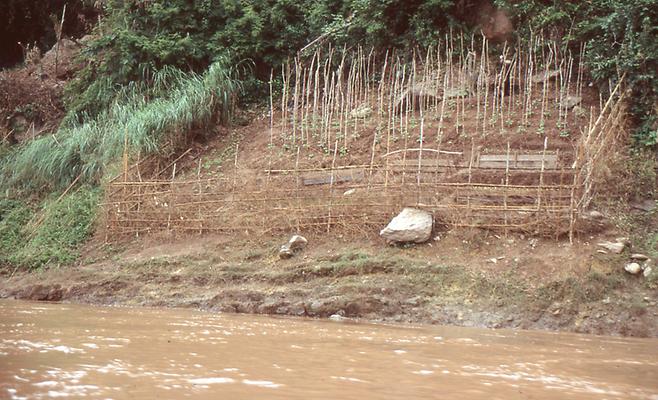
The utilization of plots on river banks for vegetable growing demonstrates the need for production of food by all means,
under CC BY 4.0
How much the river erodes the banks in order to continuously advance the delta into the sea is shown by eroded trees with bared roots:

Exotic wood is already overexploited,
under CC BY 4.0

Bamboo, the universal plant exists in suffient quantity,
under CC BY 4.0

Elegant boats are used as individual transport on the river,
under CC BY 4.0

The destination of the trip is the limestone massif of the PakOu with its caves,
under CC BY 4.0
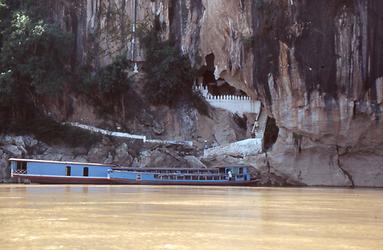
It is about 25 km from Luang Prabang and can be reached only by water,
under CC BY 4.0
Buddhist pilgrims bring along with them Buddha statutes of all sizes as votive gifts. The position of the hand of the historical Buddha Shakyamuni, including the granting of water, refers to specific concerns of the pilgrims. Often, there are also depictions of lions, because Buddha is also called The Lion of the Princely House of Shakya:
During the time of suppression of religion by rigid communism many Laotions brought their own Buddhas to this place to save them from desecration and destruction:

Reliefs with rare reptiles may mean that these are symbols of the evil that has to be defeated,
under CC BY 4.0
On the shore there are villages that are situated slightly higher than the river. They have everything that is necessary to maintain a certain level of agriculture and handicraft. A small Buddhist shrine serves the spiritual needs, the school serves for the basic education of the youth. Very simple wooden houses on stilts have started to replace their palm leaf roofs by permanent but ugly roofs of corrugated iron. Hard-working women are busy with weaving on simple looms. Chillies are spread-out as part of the garden and field economy. Local people are very friendly to visitors.

... with its nice roof ornaments,
under CC BY 4.0

The village is proud of its school,
under CC BY 4.0

Chili as a foretaste of very spicy food...,
under CC BY 4.0

Beautiful weavings are made here,
under CC BY 4.0

... is showing the consequences of chewing betel,
under CC BY 4.0
Another village concentrates on liquid distilling. Rice is mashed and distilled in a primitive way. The result is aged in large clay pots and is finally filled into bottles. Folk medicine believes that reptiles laid in alcohol have a healing effect. This seems disgusting to many Westeners. The locals are of a different opinion.
Market in Luang Prabang

Unsightly but much tastier than bananas ripened in a ship’s hold,
under CC BY 4.0

Tamarind pods of sweet sour moisture,
under CC BY 4.0
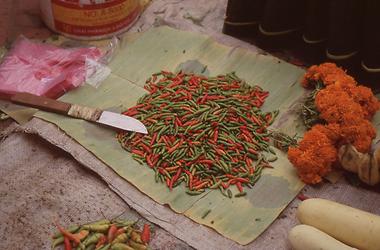
Chilli, the smaller the hotter,
under CC BY 4.0
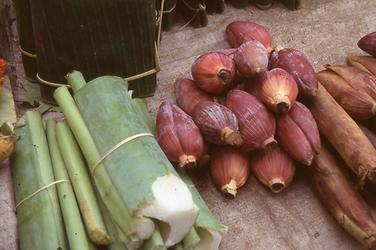
Banana blossoms, a popular vegetable,
under CC BY 4.0

Will they manage to sell such a huge quantity?,
under CC BY 4.0

Insect larvae, rich in proteins and delicious,
under CC BY 4.0

Catfish: Its ugliness is only surpassed by its pleasant taste,
under CC BY 4.0
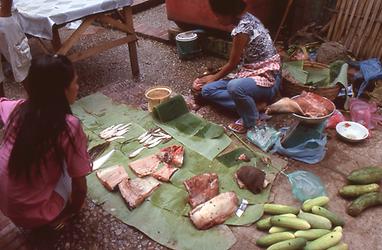
Meat, fish and next to it cucumber,
under CC BY 4.0

Dried bottoms of Lotus roots,
under CC BY 4.0
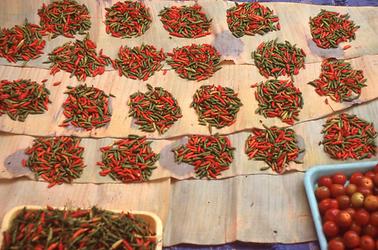
Chilli in small heaps is not milder,
under CC BY 4.0

You can even eat pig‘s trotter and pork tails,
under CC BY 4.0
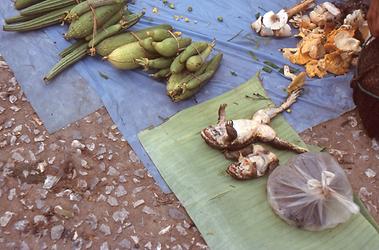
Not only French- teh former coloialists- like to eat frogs.,
under CC BY 4.0

Slily packed they cannot hurt anymore,
under CC BY 4.0

Tools which are needed in the house and on the field,
under CC BY 4.0
While food and consumer goods are offered at the daytime market, textiles and clothing are offered at night in a separate weaver's market. During the day there are markets in villages where beautiful wall drapings with figural applications and woven fabrics with depictions of everyday rural life catch the eye.

Again and again elephants as powerful animals for work,
under CC BY 4.0
The minority groups in Laos differ in their clothing. The black and dark-blue background of the clothing and the beautifully embroidered borders with floral motifs are striking.




